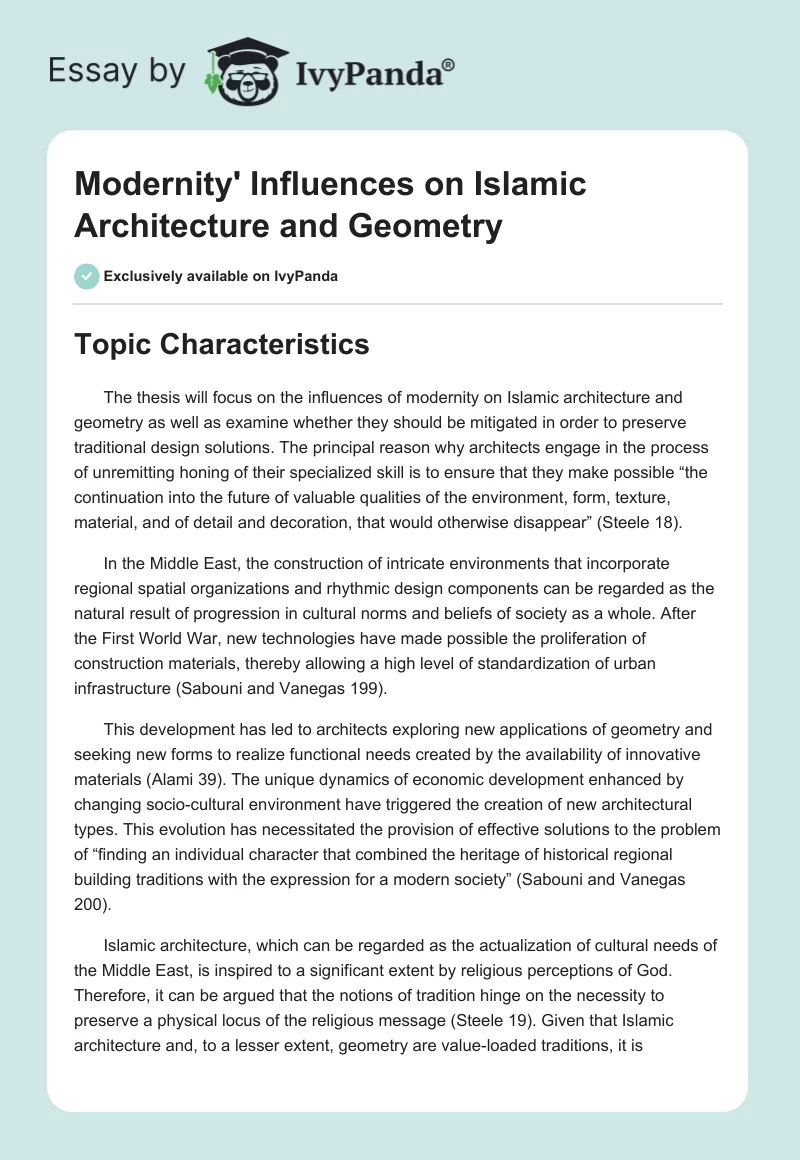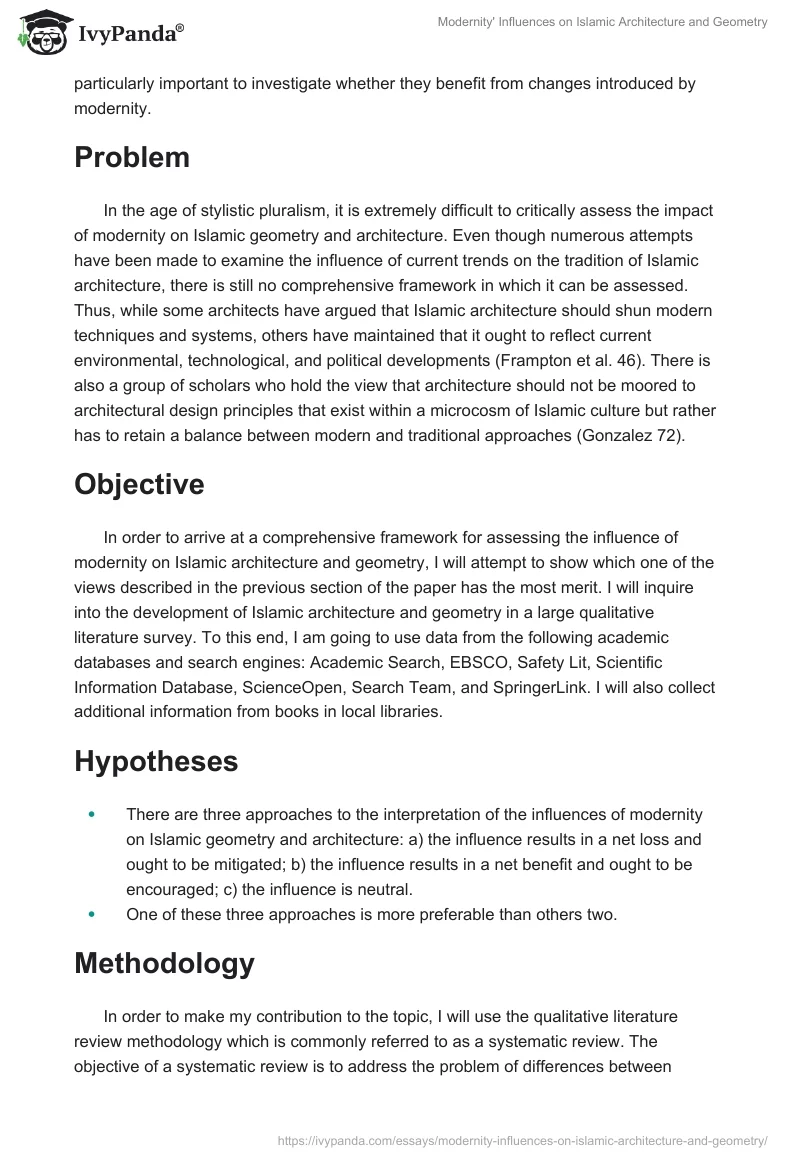Topic Characteristics
The thesis will focus on the influences of modernity on Islamic architecture and geometry as well as examine whether they should be mitigated in order to preserve traditional design solutions. The principal reason why architects engage in the process of unremitting honing of their specialized skill is to ensure that they make possible “the continuation into the future of valuable qualities of the environment, form, texture, material, and of detail and decoration, that would otherwise disappear” (Steele 18).
In the Middle East, the construction of intricate environments that incorporate regional spatial organizations and rhythmic design components can be regarded as the natural result of progression in cultural norms and beliefs of society as a whole. After the First World War, new technologies have made possible the proliferation of construction materials, thereby allowing a high level of standardization of urban infrastructure (Sabouni and Vanegas 199).
This development has led to architects exploring new applications of geometry and seeking new forms to realize functional needs created by the availability of innovative materials (Alami 39). The unique dynamics of economic development enhanced by changing socio-cultural environment have triggered the creation of new architectural types. This evolution has necessitated the provision of effective solutions to the problem of “finding an individual character that combined the heritage of historical regional building traditions with the expression for a modern society” (Sabouni and Vanegas 200).
Islamic architecture, which can be regarded as the actualization of cultural needs of the Middle East, is inspired to a significant extent by religious perceptions of God. Therefore, it can be argued that the notions of tradition hinge on the necessity to preserve a physical locus of the religious message (Steele 19). Given that Islamic architecture and, to a lesser extent, geometry are value-loaded traditions, it is particularly important to investigate whether they benefit from changes introduced by modernity.
Problem
In the age of stylistic pluralism, it is extremely difficult to critically assess the impact of modernity on Islamic geometry and architecture. Even though numerous attempts have been made to examine the influence of current trends on the tradition of Islamic architecture, there is still no comprehensive framework in which it can be assessed. Thus, while some architects have argued that Islamic architecture should shun modern techniques and systems, others have maintained that it ought to reflect current environmental, technological, and political developments (Frampton et al. 46). There is also a group of scholars who hold the view that architecture should not be moored to architectural design principles that exist within a microcosm of Islamic culture but rather has to retain a balance between modern and traditional approaches (Gonzalez 72).
Objective
In order to arrive at a comprehensive framework for assessing the influence of modernity on Islamic architecture and geometry, I will attempt to show which one of the views described in the previous section of the paper has the most merit. I will inquire into the development of Islamic architecture and geometry in a large qualitative literature survey. To this end, I am going to use data from the following academic databases and search engines: Academic Search, EBSCO, Safety Lit, Scientific Information Database, ScienceOpen, Search Team, and SpringerLink. I will also collect additional information from books in local libraries.
Hypotheses
- There are three approaches to the interpretation of the influences of modernity on Islamic geometry and architecture: a) the influence results in a net loss and ought to be mitigated; b) the influence results in a net benefit and ought to be encouraged; c) the influence is neutral.
- One of these three approaches is more preferable than others two.
Methodology
In order to make my contribution to the topic, I will use the qualitative literature review methodology which is commonly referred to as a systematic review. The objective of a systematic review is to address the problem of differences between various studies that occur for reasons that include, but are not limited to, design flaws, chance, and sampling variations (Siddaway). I will attempt to identify and critically evaluate the findings of the most relevant and high-quality extant literature on the topic of the influence of modernity on Islamic geometry and architecture that addresses at least one of the research questions.
The systematic review will try to determine to what extent existing body of literature has progressed toward clarifying the issue. It will also attempt to establish contradictions and inconsistencies in individual studies on the issue, and provide new explanations for the discussed phenomena in order to account for the contradictions. When trying to analyze the results of the literature review, I will try to adopt a judicious mindset in order to minimize bias.
Works Cited
Alami, Mohammed. Art and Architecture in the Islamic Tradition: Aesthetics, Politics and Desire in Early Islam. I. B. Tauris, 2011.
Frampton, Kenneth, et al. Modernity and Community: Architecture in the Islamic World. Edited by Philippa Baker, Thames & Hudson, 2001.
Gonzalez, Valerie. Beauty and Islam: Aesthetics in Islamic Art and Architecture. I. B. Tauris, 2001.
Sabouni, Ikhlaas, and Jorge Vanegas, editors, ACSA Houston Fall Meeting 2011, ACSA, 2011.
Siddaway, Andy. “What is a Systematic Literature Review and How do I do One?” Stir. Web.
Steele, James. Architecture for Islam Societies Today. Academy Editions, 1994.


